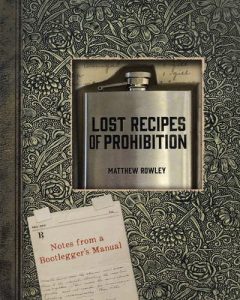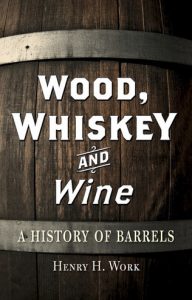
The Cocktail Chronicles: Navigating the Cocktail Renaissance with Jigger, Shaker & Glass
Paul Clark
Nashville: Spring House Press, 2015
200 pages
ISBN 9781940611174
$24.95
Paul Clarke is Executive Editor of Imbibe magazine, author of the drinks blog The Cocktail Chronicles, and writer of numerous articles about spirits and cocktails for The San Francisco Chronicle, The New York Times, Serious Eats and more. For more than 10 years, Clarke has reported from the front lines of the cocktail renaissance sweeping the nation and Europe.
Clarke’s book, The Cocktail Chronicles, is a fascinating snapshot of American cocktail culture that circuitously explores the past and present of the craft. He begins by explaining how the book diverges from a traditional presentation, with cocktails, arranged alphabetically or by spirit. Instead, chapters read more like a natural, meandering conversation.
Clarke explains his entrance into the craft cocktail world, and how the scene sprang up amidst the garish and crude cocktails of the 70s through the 90s. Chapter two highlights classic yet perhaps unfamiliar cocktails regaining their place on menus across the country. Chapter three bridges the classics and the contemporary, focusing on “five enduring classics”: the Daiquiri, Old Fashioned, Manhattan, Martini and Negroni—all deceptively simple, and forming the building blocks of endless inspiration. For each, Clarke lists half a dozen notable variations, displaying the creativity of bartenders, and serving as the jumping-off point into the fourth chapter’s contemporary cocktails. He presents several that highlight interesting ways that mezcal, pisco and aquavit are expanding the flavor palette.
Cocktail Chronicles is simultaneously informative, humorous and intimate. The nontraditional format of the material makes the book more readable by eschewing any sense of completeness or finality. Clarke takes the reader on a discovery of new and old cocktails alike that awaken the senses and add color to life.
One final note for modern spirits producers: Despite the boom in craft distilling, there are a number of spirit styles, liqueurs and bitters that remain rare. This book is a resource for producers looking to meet that growing demand. EZ
Gin: The Art and Craft of the Artisan Revival
Aaron Knoll
London: Jacqui Small, 2015
224 pages
ISBN 9781910254097
$35.00
Aaron Knoll is the author of the spirits blog, the Gin is In, co-author of The Craft of Gin, and a gin judge for the American Distilling Institute. Knoll’s latest book, Gin: The Art and Craft of the Artisan Revival, is a beautiful, elegant book that is a pleasure to read. Whereas coffee table books often tend to emphasize images over content, Gin strikes the perfect balance of well-written prose and lovely photographs.
Gin is broken up into four main sections—history, appreciation, tasting and drinking. The history section covers the evolution of gin from juniper-flavored tinctures designed by the Egyptians and Greeks to treat illnesses, to the proliferation of craft gins in both the Americas and Europe. The section on appreciation covers the basics of how gin is made, detailing how different bases and botanicals contribute to the aroma and flavor profile of gin.
The second half of the section on appreciation covers how to taste gin, and describes the several gin styles that have developed in the last few centuries. The heart of the book is the 300 gin tasting notes, arranged alphabetically and grouped by region, and include an image of the bottle, its ABV, the distillery, where it is made, and a short description of how it tastes. Within this section, Knoll includes a few distillery profiles that explore the creation and inspiration of various gins. Finally, the section on drinking includes recipes for the major gin cocktails, as well as suggestions for each gin style—particularly helpful for knowing how to put that old tom or barrel aged gin sitting on your liquor shelf to best use.
Knoll’s biography describes the night he fell in love with gin—a fateful encounter with Martin Miller’s Gin at a bar in Buffalo, NY. Gin: The Art and Craft of the Artisan Revival is a celebration of that love. His passion for the spirit comes through loud and clear through his prose and beautiful images. This book is highly recommended for anyone who loves gin and wants to share that love with everyone they know. EZ

Lost Recipes of Prohibition: Notes from a Bottleggers Manual
Matthew Rowley
Countryman Press, 2015
256 pages
ISBN 9781581572650
$27.95
If there ever was a page-turner in the field of spirits books, Matthew Rowley’s Lost Recipes of Prohibition is it. The sleuth work involved in not only understanding the recipes, but the life of Victor Lyon—the original author of a found notebook—and the reason behind the notebook’s disguised and secretive existence, left me hungry for more every time I had to put it down. And I often found myself thinking about the book when I was away.
Lyon is a person for whom no known photograph exists, and the notebook itself bears the cover of an obscure volume of poetry by a banned author whom Rowley describes as a “venom-bloated toad of treason.” The unraveling of the story is both fascinating in its details and revealing to anyone who may struggle with the strange mixtures of English, German, French and Latin—all required to decipher apothecary texts and antique spirits recipes. The book describes the devious and sometimes poisonous techniques that bootleggers used to stretch out an insufficient supply of a spirit, or to counterfeit gin, whiskey, rum, brandy, cider, wine, absinthe and cordials out of neutral spirits. Many of the recipes hold secrets still in use by some of the finest producers of spirits today. Lyon also sprinkled the original notebook with recipes for many of the classic cocktails that have seen a revival in recent years.
Rowley provides generous doses of these recipes, updated to fit modern ingredients and 21st century liquor brands. The pages are beautifully interspersed with scans of the original notebook, old advertisements, prescriptions, postcards and some notes from the author, which sometimes imply “Children, don’t try this at home.” Lost Recipes of Prohibition is a delightful read that also serves as a valuable reference into obscure methods of flavor creation and the dark side of
spirits history. AF
Wood, Whiskey and Wine: A History of Barrels
Henry H. Work
London: Reaktion Books, 2014
224 pages
ISBN 9781780233567
$35.00
Henry H. Work is an American cooper currently living in New Zealand. He learned his craft in California’s Napa Valley and continued its application in Kentucky’s bourbon country. Wood, Whiskey and Wine is an interesting read full of fascinating information, not all of which feels necessary or completely believable. In 14 chapters, Work covers the history of containers for bulk goods from 1800 BCE to the present. The chapters generally flow chronologically from the Celtic origin of the barrel, its Roman adoption, and spread across the Mediterranean world, becoming the Western world’s most popular container for intra- and international trade.
Wood, Whiskey and Wine succeeds in telling the stories of wooden barrels and how their construction and use impacted the economic, environmental, labor and cultural histories of the Western world. Work describes how the Celts invented the wooden barrel through a unique nexus of iron tools, wood working skills, abundance of oak and a love of wine. Since its invention 2000 years ago, the basic design of the barrel largely remains unchanged, due to its utility for wet and dry goods, as well as its relative ease of movement. While the title of the book focuses the reader’s attention on symbiotic relationship of barrels and alcoholic beverages, Work devotes considerable space to explaining the important roles barrels played in facilitating exploration and the exploitation of whale oil and crude oil for the world’s energy needs.
In the end, Wood, Whiskey and Wine struggles for cohesion. Its scope and structure are too broad for a single narrative thread to carry through. Work’s detours on the Roman amphora, the adventures of Captain Cook, and description of 19th century whaling practices are more a distraction than a vital part of the narrative. Work closes the book as a lament for the former glory days of the barrel, which is both a depressing and confusing way to end the book. Despite being published in 2014, Work seems ignorant of the growing demand for barrels by wineries, breweries and distilleries. There seems to be reason for hope and excitement for the future of barrels in the craft beverage industry, which both sustains their utility and their mystique. EZ










